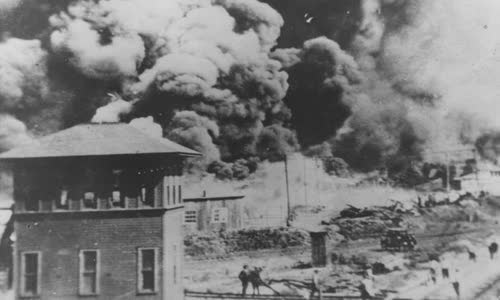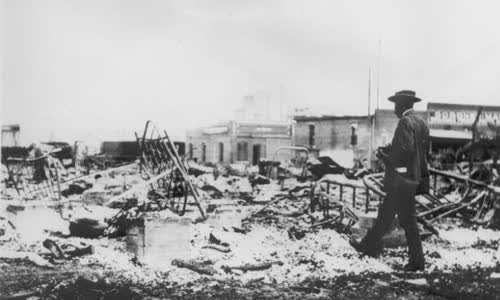Nearly 100 years ago, a tragedy occurred after young Dick Dickland walked into the elevator with white teenager Sarah Page.
Page, 17, is the elevator operator at Drexel building, Tulsa city, Oklahoma, USA.

Smoke rises on June 1, 1921 during an attack on colored people in Greenwood County, Tulsa City, Oklahoma, USA Photo: University of Tulsa.
"Still not sure what happened in the Drexel building that day, but the most common explanation was that Rowland stepped on Page's foot when she stepped into the elevator, causing her to scream," said the Oklahoma History Association.
After the elevator door opened, Roland fled, but was arrested again because Page claimed she was attacked.
The local newspaper, Tulsa Tribune, published the following day with the headline "Summary of a black man who attacked a girl in an elevator," and wrote a disturbing editorial called "Lynch executions with black men on."
The incident took place in the years after World War I, a time of intense racial tension, including the rise of Ku Klux Klan, the secret society promoting the superior white theory.
The city of Tulsa is especially divided.
According to Mechelle Brown, director of programs at the Greenwood Cultural Center, the success of the black community has made some white people in Tulsa jealous and angry.
The incident in the elevator between Rowland and Page caused stress to be pushed to the climax.
At about 9pm on May 31, 1921, a group of about 25 armed black men, many of whom were World War I veterans, went to court to ask to protect Rowland, but were not allowed to.
Due to rumors of Rowland's death, about 75 black men decided to return to the court shortly after 10pm, where they clashed with about 1,500 white men, many of whom also brought men.
Several hours later, the white groups in Tulsa, including some who were appointed by the police to represent and own the weapons, committed many acts of violence against blacks, like shooting a man.
Further agitation was caused by the misunderstanding by the white faction that blacks in Tulsa were plotting a major insurgency, with reinforcements from neighboring African-American towns and cities.

An African American amid ashes after the riots of 1921 Photo: Oklahoma Historical Society.
As early as June 1, 1921, thousands of white residents flocked to Greenwood County to plunder, burn homes and businesses.
According to estimates of the Red Cross, about 1,256 houses were burned, 215 others were robbed.
"They try to kill every colored person they see," recalls George Monroe, one of the survivors of the tragedy.
"They take everything they think is valuable and destroy all that remains," said Olivia Hooker, another survivor.
By the time the National Guard arrived at Greenwood and declared martial law just before noon, the riots had ended.
Racism in Tulsa continues to increase following the riots.
The Tulsa Tribune newspaper deleted an article that sparked chaos on May 31, 1921.
The official report at the time of the event recorded 36 deaths, including 10 white people.
According to a 2001 report by the Commission against Race Riot, an agency established by the Oklahoma state government to investigate the event, about 100-300 people were killed, more than 8,000 were homeless within 18 hours due to
In November 2018, the agency was renamed the 1921 Race of Massacre, based on "the emotions and perspectives of witnesses", as well as current area residents and historical scholars.
All that remains of "Black Wall Street" are only 14 red buildings rebuilt shortly after the massacre.



 Ingrid Viaene
Ingrid Viaene







